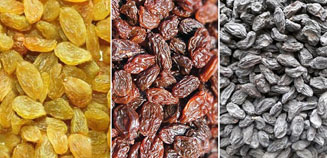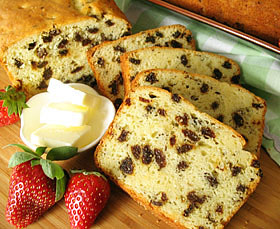Raisins Nutrition facts
Raisins are dried grapes/currants. However, unlike fresh grapes, they are indeed rich and concentrated sources of energy, vitamins, electrolytes, and minerals. On a weight-per-weight comparison basis, 100 g of dried grapes hold 249 calories, and several times more fiber, vitamins, minerals, and polyphenol antioxidants than the fresh grapes.
Raisins, however, contain fewer amounts of vitamin C, folic acid, carotenes, lutein, and xanthins than fresh grapes.
 |
| Raisins! |
In general, fresh grapes, either seedless or seed types of the Vinifera species such as Thompson seedless (Sultana), Sugarone, Calmeria, Corinth, etc., are subjected to dry under sunlight or mechanical drying techniques. In some cases, the whole bunch of grapes may be allowed to dry on the plant itself (vine-dried). Ordinarily, their moisture content should not exceed 16% of dry weight.
Thoroughly dried raisins are then further stemmed, cap-stemmed, sorted, and cleaned in order to obtain high-quality, dried berries. At the wholesale level, raisins are processed and graded further before being sent to the markets.
Types (varieties) of processed raisins:
Type I - Seedless.
Type II - Golden seedless.
Type III - Raisins with seeds.
Type IV - Sultana.
Type V - Zante currant.
Type VI - Mixed species or varieties.
10 Amazing Health Benefits of Raisins
Raisins, like dried apricots, figs, and prunes, are dense sources of energy, vitamins, minerals, and antioxidants. Additionally, they are packed with many health-benefiting polyphenolics antioxidants, dietary fiber, and other phytonutrients.
The total measured antioxidant strength (ORAC value) of 100 g raisin is 3037 µmol Trolox Equivalents (TE), while that of fresh grapes is 1118 µmol TE/100 g.
As in grapes, raisins also contain phytochemical compound resveratrol. Resveratrol, a polyphenol antioxidant, has anti-inflammatory, anti-cancer, and blood cholesterol-lowering activities. Studies suggest that resveratrol has been found to have protective action against cancers like melanoma, colon, and prostate, and diseases such as coronary heart disease (CHD), degenerative nerve disease, Alzheimer's disease, and viral/ fungal infections.
Also, resveratrol reduces stroke risk by altering the cell molecular level inside the blood vessels. It does so firstly by reducing the susceptibility of blood vessel damage by decreasing the activity of angiotensin (a systemic hormone causing blood vessel constriction that would elevate blood pressure) and secondly, through increased production of the vasodilator substance, nitric oxide (a beneficial compound that causes relaxation of blood vessels).
Like in grapes they, especially those derived from red/purple grapes, are very high in anthocyanins, another class of polyphenolic anti-oxidants. Anthocyanins have been found to have anti-allergic, anti-inflammatory, anti-microbial, and anti-cancer activities.
100 g raisins provide 3.7 g or 10% of the daily required levels of dietary fiber. Studies suggest moderate fiber in the diet helps lower body weight, cholesterol concentrations in the blood, and colon and breast cancer incidence. Additionally, it helps relieve constipation episodes by decreasing the gut transit time of food. Furthermore, they are also abundant in flavonoid compounds such as tartaric acid, tannins, catechins, etc. Together with inulin and fiber, these compounds aid in smooth bowel movements through their laxative function.
They are free of gluten protein and can be safely consumed as an alternative healthy food by people who are intolerant to gluten.
Raisins are dense sources of minerals like calcium, iron, manganese, magnesium copper, fluoride, and zinc. Copper and manganese are essential cofactors for the antioxidant enzyme, superoxide dismutase. 100 g provides 23% daily requirement levels of iron.
Further, they are rich in a heart-healthy electrolyte, potassium. 100 grams hold 749 mg of potassium. By countering the pressing effects of sodium, it reduces heart rate, and blood pressure and thereby helps prevent stroke, CHD, and peripheral vascular diseases.
Furthermore, they are also a good source of some B-complex vitamins such as thiamin, pyridoxine, riboflavin, and pantothenic acid.
| Principle | Nutrient Value | Percentage of RDA |
|---|---|---|
| Energy | 299 Kcal | 15% |
| Carbohydrates | 79.18 g | 61% |
| Protein | 3.07 g | 5.5% |
| Total Fat | 0.46 g | 1.5% |
| Cholesterol | 0 mg | 0% |
| Dietary Fiber | 3.7 g | 10% |
| Vitamins | ||
| Folates | 5 µg | 1% |
| Niacin | 0.766 mg | 5% |
| Pantothenic acid | 0.095 mg | 2% |
| Pyridoxine | 0.174 mg | 13% |
| Riboflavin | 0.125 mg | 10% |
| Thiamin | 0.106 mg | 9% |
| Vitamin A | 0 IU | 0% |
| Vitamin C | 2.3 mg | 4% |
| Vitamin E | 0.12 mg | 1% |
| Vitamin K | 3.5 µg | 3% |
| Electrolytes | ||
| Sodium | 11% | 1 mg |
| Potassium | 749 mg | 16% |
| Minerals | ||
| Calcium | 50 mg | 5% |
| Copper | 0.318 mg | 35% |
| Iron | 1.88 mg | 23% |
| Magnesium | 7 mg | 2% |
| Manganese | 0.299 mg | 12% |
| Phosphorus | 101 mg | 15% |
| Selenium | 0.6 µg | 1% |
| Zinc | 0.22 mg | 2% |
| Phyto-nutrients | ||
| Carotene-α | 0 µg | -- |
| Carotene-ß | 0 µg | -- |
| Crypto-xanthin-ß | 0 µg | -- |
| Lutein-zeaxanthin | 0 µg | -- |
Selection and storage
Raisins come in different grades, grape varieties, and brands. While buying, look carefully for high-grade raisins from authentic brands.
Buy raisins that are full-fleshed, and plump in appearance. It is perfect to have fine wrinkles. Always choose high-quality grapes since substandard berries have thin flesh, and poor taste, and flavor.
Avoid old stocks as well as those with excess moisture, mold, or affected by sunburn, scars, insect injury, or a mechanical injury which may seriously affect their appearance, edibility, and keeping-quality.
Being a dry fruit, raisins have a long shelf life. They stay well when stored in airtight containers and placed away from moisture, humidity, sunlight, and high temperatures. They can also be stored in the refrigerator.
Prolonged cold storage may result in precipitation of their sugar contents. However, this should not offset their quality. It can be reversed by just soaking them in boiled water for a few minutes in order to dissolve sugar crystals.
Preparation and serving method
 |
| Irish bread with added raisins. Photo: Kathy Maister |
Raisins are one of the most sought-after items used in the confectionary.
Here are some serving tips:
Enjoy as a snack, without any additions.
Sprinkle over fruit salads and ice creams, desserts, etc.
Add to bakery items like chocolates, cookies, muffins, bread, puddings, biscuits, cakes, waffles, etc.
In Iran, India, Pakistan, and other South Asian regions, they are popular as kismish (sultanas), added to various sweet and savory dishes.
They can be enjoyed with other dry fruits (apricots, dates, prunes) and nuts like almonds, cashew, macadamia...etc.
Safety profile
Raisins, especially the golden variety, are treated with sulfur dioxide that may aggravate asthma and other allergic reactions in sulfur-sensitive persons. Read carefully the labels which may instruct about sulfur-treated products before use. However, natural sun-dried products are safe to use even in these people. (Medical disclaimer).
Also read ≻≻-
≺≺ Grapes nutrition facts.
≺≺ Goji berry nutrition facts.
≺≺ Back to Fruits from Raisins. Visit here for an impressive list of all varieties of fruits with complete illustrations of their nutrition facts and health benefits.
≺≺ Back to Home page.
Further reading and Resources:
Refer Stanford School of Medicine Cancer information Page- Nutrition to Reduce Cancer Risk.